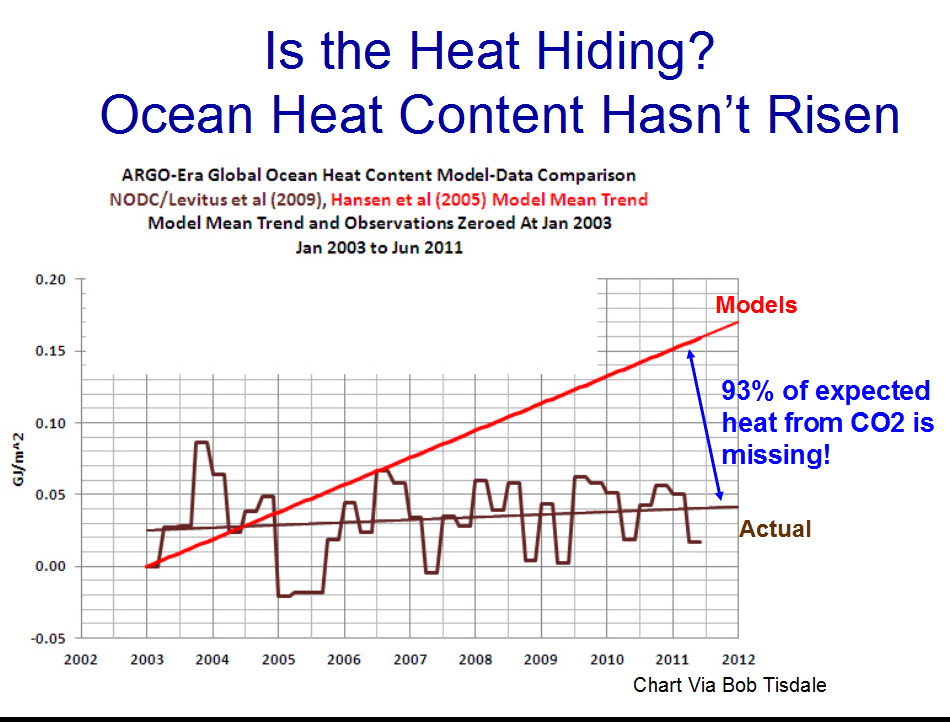 |
| Not from anthropogenic global warming |
"The direct radiative forcing of CO2 drives a weak poleward jet shift in both hemispheres"The paper goes on to claim
"the indirect (Sea Surface Temperature) component of the CO2 forcing dominates the total response and drives a zonally asymmetric response in the Northern Hemisphere. Hence, understanding the Sea Surface Temperature-mediated component of atmospheric CO2 forcing appears crucial to unlocking the mechanisms that contribute to forced extratropical circulation changes."The major problem with this assumption of "indirect CO2 forcing" on sea surface temperatures is that longwave IR radiation from greenhouse gases cannot significantly heat the oceans, and ocean heat capacity is 1000 times greater than the atmosphere, therefore the ocean wags the tail of the atmosphere. These major physical bugaboos & false assumptions built into all climate models are perhaps the primary reason why 93% of Trenberth's missing CO2 heat is still missing from the oceans.
The response of mid-latitude jets to increased CO2: Distinguishing the roles of sea surface temperature and direct radiative forcing
Kevin M. Grise and Lorenzo M. Polvani
In Coupled Model Intercomparison Project Phase 5 (CMIP5) models, the zonal-mean tropospheric circulation shifts robustly poleward in the Southern Hemisphere (SH) extratropics in response to increased atmospheric CO2 concentrations. However, in the Northern Hemisphere (NH) extratropics, the circulation response to CO2 is largely absent in the zonal mean, and is instead characterized by complex regional anomalies. This study decomposes the atmospheric circulation response to CO2 forcing in CMIP5 models into two components: a direct component due to CO2 radiative forcing and an indirect component associated with sea surface temperature (SST)-mediated changes. The direct radiative forcing of CO2 drives a weak poleward jet shift in both hemispheres, whereas the indirect (SST) component of the CO2 forcing dominates the total response and drives a zonally asymmetric response in the NH. Hence, understanding the SST-mediated component of atmospheric CO2 forcing appears crucial to unlocking the mechanisms that contribute to forced extratropical circulation changes.
Record cold from global warming causing 'polar vortex' debunked
Climate models robustly predicted the opposite of what has caused the record cold US weather

A minor quibble regarding comments following the abstract, neither of which affect the validity of the comments.
ReplyDeleteThe total heat capacity of the world ocean is not relevant to the process of heat sequestration in the oceans. This is because Newton's law of cooling also applies to heating. The equilibrium temperature gradient from the sea surface to deeper levels is negative exponential, both from theory and observations. This claim is consistent with the figure Roy Spencer derived from his physical model, in turn derived from an IPCC graphic with a different parameter value. URL: http://www.drroyspencer.com/2011/06/
The relevant mass of the ocean to compare with the atmosphere is a curved and tapered column of water bounded on the left and right by negative exponential curves, one with no change in net radiative flux at the sea surface and the other with the observed change.
The mass equivalent to the atmosphere is the mass of water represented by these two curves. Conceptually, as this curved column becomes thinner with depth its width approaches zero. Thus the mass of water equivalent to the atmosphere can be approximated by integral calculus or by numerical methods in a spreadsheet model such as that used by Roy Spencer.
Dr Spencer set the parameters of his model to replicate a figure in a 2007 IPCC report. The IPCC figure was almost certainly based on or consistent with ocean heating +0.85 Wm-2 (Hansen et al, 2005) However, Hansen and colleagues later revised their estimate downward by 30% to 0.58 Wm-2 (Hansen et al.2011)
With a crude model extending to 700 meters depth, I confirmed the consistency of Dr Spencer's climate sensitivity to CO2 of +1.3 degrees C with Hansen's 2011 estimate of +0.58 Wm-2.
My conclusion:
At a depths below about 350 meters the difference in sea temperature for sensitivities of 1.3 degC and 2.1 degK is a little more that 0.1 degC tapering to 0.1 degC at 700 m.
Compared with no increase in net radiative flux, the difference in temperature at great depth would be zero. Therefore the mass of the ocean that has been warmed since 1950 is great enough to contain the accumulated heat energy with a rise of only 0.1 degree Celsius during the period 1950 to 2000 to a depth of 700 meters. Other data indicates a tapering to almost zero at 2000 meters. (The average depth of the world ocean is 4000 meters over 70% of the Earth's surface.)
In 50 years we have had an effective rise in ocean temperature of 0.1 degC. Assuming three times the cumulative increase in net radiative flux to the end of the century in line with industrialization of most developing countries, the gradients would not steepen more that about 0.4 degC compared with 1950.
Since the oceans controls the climate and not the other way around, it would take centuries for global climate to change radically. This is confirmed by the climate history of the globe since Minoan times, about 1500 BC. Quasi-periodic changes in climate have shown that It takes around 750 years for climate to change from warm to cold and about 750 years to switch back again.
Only the oceans have an enough heat capacity to modulate climate over such long time spans.
Earth’s energy imbalance and implications, Atmos. Chem. Phys., 11, 13421-13449, 2011).
URL:
http://www.atmos-chem-phys.net/11/13421/2011/acp-11-13421-2011.pdf